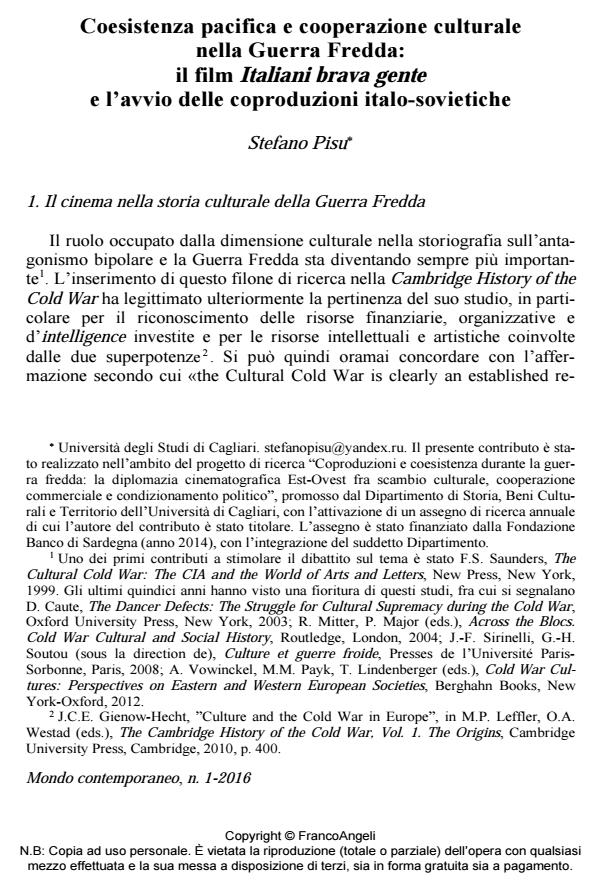Peaceful Co-existence and Cultural Cooperation during the Cold War: The Film Italiani brava gente and the Birth of Italian-Soviet Co-productions
Journal title MONDO CONTEMPORANEO
Author/s Stefano Pisu
Publishing Year 2016 Issue 2016/1
Language Italian Pages 28 P. 35-62 File size 281 KB
DOI 10.3280/MON2016-001002
DOI is like a bar code for intellectual property: to have more infomation
click here
Below, you can see the article first page
If you want to buy this article in PDF format, you can do it, following the instructions to buy download credits

FrancoAngeli is member of Publishers International Linking Association, Inc (PILA), a not-for-profit association which run the CrossRef service enabling links to and from online scholarly content.
This article deals with the origins and making of Giuseppe De Santis’ film Ital-iani brava gente (1964) that depicts the Italian military campaign in the Ussr dur-ing the Second World War. This was the first Italian-Soviet film co-production and paved the way for the signing of the intergovernmental agreement in 1967. The essay reveals challenges and problems of the East-West film co-productions and the cultural dimension of the Cold War at the time of so-called peaceful coexist-ence. From the creative and cultural point of view, the director’s intent to make a film on the friendship between Soviet and Italian peoples went along with the rep-resentation of the “bad German”, a widespread image in both countries. The Ital-ian-Russian cooperation, however, was jeopardized by political and ideological reasons, in particular by the suspicious attitude of the Soviets towards the produc-ers, who received an American grant to finance the production, as well as towards the Italian Communist Party, who supported the project. The idea that stood be-hind the movie, and the film making itself, prove that both countries aimed to strengthen their good bilateral relations in the 1960s. At the same time, however, the difficulties of the whole project reveal a problem of communication between Soviet and Italian Communists, that would eventually degenerate in the following years. Nevertheless, the case of Italiani brava gente demonstrates also that the Iron Curtain was penetrable and that the negotiating attitude of all the people in-volved in the production made it possible to go across it.
Keywords: Cultural Cold War, film industry, international film co-productions, Soviet-Italian relations, peaceful co-existence, Giuseppe De Santis
- Il mondo slavo e l’Europa Claudia Olivieri, pp.317 (ISBN:978-88-6453-909-6)
- Il mondo slavo e l’Europa Claudia Olivieri, pp.317 (ISBN:978-88-6453-909-6)
Stefano Pisu, Coesistenza pacifica e cooperazione culturale nella Guerra Fredda: il film Italiani brava gente e l’avvio delle coproduzioni italo-sovietiche in "MONDO CONTEMPORANEO" 1/2016, pp 35-62, DOI: 10.3280/MON2016-001002